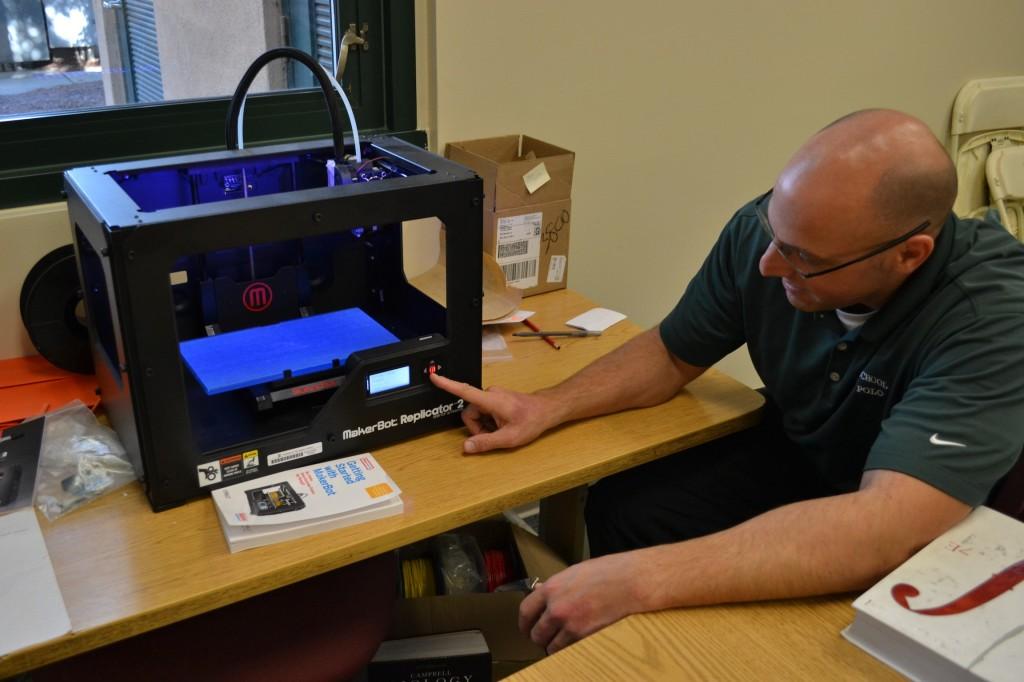New, innovative products unveiled at CES
Math teacher Victor Adler demonstrates the 3D printer located in his room. He has used this gadget in his classes to demonstrate 3D modeling.
The Las Vegas Convention center buzzed with excitement as tech companies unveiled their latest innovative ventures at the Consumer Electronics Show (CES) hosted by the Consumer Electronics Association (CEA) from Jan. 7 to Jan. 10.
From experienced companies like Intel to startups like Kolibree, innovators across the world debuted vast new collections with products ranging from cars to wearable devices. CES serves as an annual platform for these companies to announce their latest technologies and for consumers to keep aware of ongoing innovations.
Vamsi Gadiraju (11) expects that many of the products coming out this year and in the near future will deal with connecting devices to the Internet.
“I read articles about how the Internet of things is becoming larger, so one of the priorities of these companies is probably attaching all devices to the Internet, like refrigerators that can access the Internet,” he said. “I think that’s just a great step forward because now you have the access to understand truly where our energy is used and be able to minimize energy use in that way as well.”
Kilian Burke (12) also anticipates technology that will allow users to connect across their various electronic devices.
“I think tech companies should be focusing on how people can use the devices they already own to interact between themselves, like how can my phone interact with my car or my house?” he said.
The next CES will take place in Las Vegas from Jan 6. to 9, 2015.
Kolibree Smart Toothbrush:
Dubbed “the world’s first connected toothbrush,” Kolibree came out with a smart toothbrush, which uses sensor technology to track user’s daily brushing habits.
The brush can also sync to smartphones to show data on what areas of the mouth a user may be missing and includes games encouraging users to brush better next time. The app encourages families to use the technology together by allowing five users to share one account.
Neymika Jain (9) voiced her displeasure with the product idea.
“You already have electronic brushes that are really, really high performance. You don’t really need to have that constant thing, ‘Oh am I brushing right?’ That’s for perfectionists,” she said.
The company has not specified the release date of the product.
Lumolift
LumoBodyTech came out with the Lumolift, a chip sized gadget designed to improve posture.
The device clips on magnetically and can be worn anywhere around the chest area as jewelry or hidden below clothing. With the help of a smartphone app, it keeps track of when the wearer is slouching and can be set to vibrate as a reminder to stand up straight. The Lumolift also records a user’s steps, calories, and mileage.
Divya Rajasekharan (9) doubts the product will gain a significant user base.
“That’s pretty cool if you really care about your posture maybe, but I don’t think anyone else would really use that. While posture may be important, I wouldn’t want to go through that all day,” she said.
The product will be available in late spring for around $59 to $79.
June:
The latest in wearable technology, the June created by Netatmo intends to protect users from sun damage by monitoring exposure and suggesting ways to prevent UV damage, all while disguised as jewelry.
Users can check their sun exposure on an app that connects with the bracelet in order to “be sun savvy,” as Netatmo says.
Available in three colors with a detachable centerpiece, the June can be worn as a bracelet or a brooch.
Netatmo has not released information regarding the release of June.
Intel Smart Bowl:
The Intel Smart Bowl offers a way to wirelessly charge electronic devices with magnetic resonance technology.
Although the ten-inch diameter bowl currently works only for Intel’s new smart headset, the company plans to expand its uses to phones, tablets, and other devices.
Proclaimed one of the stars of CES, the bowl has received primarily positive attention.
“I need one now. But seriously that is futuristic, we are in the future now, that is something that needs to be mass produced, something that needs to be out there and done. Give it to people because it is a really smart idea,” Conor Martin (9) said.
Raymond Xu (9) voiced why he doesn’t believe there is a need for the product.
“Intel should spend its time doing better stuff. I don’t think it’s that great of a product,” he said. “I don’t think anyone’s going to want to carry a bowl everywhere they go.”
Intel has not released any details surrounding when the bowl will be released.
Eyelock myris Iris Scanner:
The Eyelock myris is a biometric security device that scans your eye to allow you access to your electronics.
Compared to fingerprint scanners, this computer mouse-size scanner has a much higher accuracy rate and a lower risk of hacking with a one in two trillion chance of a false match.
Zahra Budhwani (9) does not see the need for such a product, although she acknowledges its technological prowess.
“I think that’s really cool, but I’m not sure how well that would work with the general public. The general public usually doesn’t need such high security on their computers, but it’s still a pretty ingenious idea,” she said.
The product will be released in this coming year.
Ford Solar-Powered Car:
Taking a new step in the production of environmentally-friendly cars, Ford has created the C-MAX Solar Energi Concept car, which can recharge its batteries under the sun in eight hours.
While the company has designed an aluminum canopy to concentrate sunlight onto the panels, it still needs to resolve other issues, such as how the car would function in areas with tall buildings or little sunlight.
Having these solar cells on top of the car will also eliminate the need for consumers to charge their cars or go to a gas station.
As the car is still in prototype stages, it will be a while before consumers can buy the vehicle.
This piece was originally published in the pages of the Winged Post on Jan. 27, 2014.

Kacey Fang (12) is the Managing Editor for The Winged Post. She has been part of the journalism program since freshman year and served as Features Editor...

Alexis Gauba is a reporter for The Winged Post. She is a freshman, and it is her first year on the staff. Alexis is on the varsity girls golf team and...


















![“[Building nerf blasters] became this outlet of creativity for me that hasn't been matched by anything else. The process [of] making a build complete to your desire is such a painstakingly difficult process, but I've had to learn from [the skills needed from] soldering to proper painting. There's so many different options for everything, if you think about it, it exists. The best part is [that] if it doesn't exist, you can build it yourself," Ishaan Parate said.](https://harkeraquila.com/wp-content/uploads/2022/08/DSC_8149-900x604.jpg)




![“When I came into high school, I was ready to be a follower. But DECA was a game changer for me. It helped me overcome my fear of public speaking, and it's played such a major role in who I've become today. To be able to successfully lead a chapter of 150 students, an officer team and be one of the upperclassmen I once really admired is something I'm [really] proud of,” Anvitha Tummala ('21) said.](https://harkeraquila.com/wp-content/uploads/2021/07/Screen-Shot-2021-07-25-at-9.50.05-AM-900x594.png)







![“I think getting up in the morning and having a sense of purpose [is exciting]. I think without a certain amount of drive, life is kind of obsolete and mundane, and I think having that every single day is what makes each day unique and kind of makes life exciting,” Neymika Jain (12) said.](https://harkeraquila.com/wp-content/uploads/2017/06/Screen-Shot-2017-06-03-at-4.54.16-PM.png)








![“My slogan is ‘slow feet, don’t eat, and I’m hungry.’ You need to run fast to get where you are–you aren't going to get those championships if you aren't fast,” Angel Cervantes (12) said. “I want to do well in school on my tests and in track and win championships for my team. I live by that, [and] I can do that anywhere: in the classroom or on the field.”](https://harkeraquila.com/wp-content/uploads/2018/06/DSC5146-900x601.jpg)
![“[Volleyball has] taught me how to fall correctly, and another thing it taught is that you don’t have to be the best at something to be good at it. If you just hit the ball in a smart way, then it still scores points and you’re good at it. You could be a background player and still make a much bigger impact on the team than you would think,” Anya Gert (’20) said.](https://harkeraquila.com/wp-content/uploads/2020/06/AnnaGert_JinTuan_HoHPhotoEdited-600x900.jpeg)

![“I'm not nearly there yet, but [my confidence has] definitely been getting better since I was pretty shy and timid coming into Harker my freshman year. I know that there's a lot of people that are really confident in what they do, and I really admire them. Everyone's so driven and that has really pushed me to kind of try to find my own place in high school and be more confident,” Alyssa Huang (’20) said.](https://harkeraquila.com/wp-content/uploads/2020/06/AlyssaHuang_EmilyChen_HoHPhoto-900x749.jpeg)



